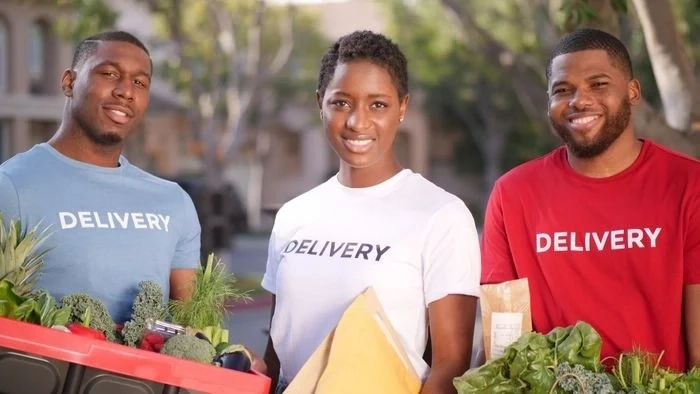Restaurant delivery is a fast-growing industry today. Research shows, that its size will multiply more than twice in the recent 5 years, from $140 million in income in 2022 to $320 million in 2029 worldwide. But this growth is largely driven by technical progress, and, accordingly, the software ensures rapid enterprise scaling. To better understand how these two components interact, we decided to start with a review of online food ordering web app statistics.
People prefer doorstep delivery because it is simply convenient. Around 63% of customers rather order ready-made dishes and watch TV with family than dine out. Moreover, ⅗ of them emphasized the easiness of using online restaurant food ordering software, and ⅓ stated app delivery is much faster than picking up products by themselves. Finally, around 87% of clients think the service makes their life painless. In that case, the entrepreneurs’ task is to simplify the whole process and make the best user experience with their food ordering web application.
Most restaurants and delivery companies develop native apps to grow their customer base, increase profit and popularize brands. But they come with several significant disadvantages, such as:
- Integrated with various platforms, software development can cost too much, especially for business beginners.
- Native apps require a lot of memory on mobile devices, which can make an additional annoyance for users.
- Mobile applications are not always user-friendly. Also, they can crush while operating due to technical problems. Faced with such discomfort, customers can even immediately delete a program from their gadgets.
In a highly competitive environment, entrepreneurs should find innovative ways to please constant clients and involve new ones. So, how to overcome these challenges? Building a progressive web application for food ordering will help to engage clients in your business. Such software looks like a native one but is faster, lighter, provides an excellent user experience (UX), works offline, and doesn’t require installation.
This article tells how to create a delivery PWA app and what factors to consider for the best consumer engagement.
Overview of the audience using Food Ordering PWA
It doesn’t matter whether you serve food of your own production or just deliver someone else’s, a mobile presence is a crucial issue in your business development. Food web apps are a splendid way to top up your company’s exposure and reach new clients.
If you open your restaurant, it might be a smart move to build a PWA simultaneously. Creating multichannel selling, you’ll organize a direct food serving at your brick-and-mortar establishment and remote ordering at the same time. Already have your own website and a mobile app? Optionally, you can migrate to food delivery with PWA. And React Native will help with this issue for your further sales growth and high-quality UX.
Suppose you don’t own a restaurant and not going to open one in the nearest future. That’s not a problem: you can deliver food from other places, making a profit on commission fees. This business provides an opportunity to partner with dozens of cafes, shipping orders to the direct customers’ doors. In this case, food delivery with the PWA app can improve customer interaction and raise conversion rates.
Consumers’ better experience makes them return to a high-level service again and again. So let’s see how using digital progressive web applications for restaurants affect users:
- 25% of them have at least one mobile app for food delivery on their smartphones.
- 70% of customers confess they prefer to see a menu from their gadgets rather than a desktop version.
- Most clients find it very annoying if they have to call for making a food order instead of doing it in the app. One-third of them can even leave you in favor of another supplier, who could provide a more convenient service with a PWA food ordering.
- 31% of mobile app users make their orders twice a week, watching restaurants\' menus even offline.
- 12% of Americans have used a food delivery option for the past 3 months.
- Clients spend 20% more costs per order with a smartphone, thanks to additional proposals from the company.
- With a mobile app, users\' desire to buy ready-made dishes increase on 6%. They’ll more likely become a constant buyer with a customer-centered service.
Food ordering software for restaurants has become a convenient way to engage clients and simplify their efforts while interacting with you. It can provide different possibilities to users at their fingertips, like menu, location, loyalty program, restaurant hours, and payment options. As a result, business becomes more available to your customers and flexible all while growing the brand’s value.
Moreover, by creating a progressive web app for food delivery, you break such barriers as slow internet connection, lack of gadgets memory, and allowing to browse for purchases right from the home screen. With such a service, you can count on visitors’ positive first and lasting impressions more confidently. So what does it mean to business owners? PWAs may help with a decrease in bounce rates, customer base growth, and profit elevation.
And now, let’s find out how to create a food ordering app that will contain all the necessary features for customers’ convenience and your brand’s visibility.
PWA vs Native App: How to Choose the Right Mobile Applications
Site characteristics that will differentiate your brand
Although the PWA copies the native mobile programs, it’s a hybrid, developed as a website using CSS, JavaScript, and HTML. Users browse progressive applications with a URL like a responsive site and don’t need any downloading.
PWA usage doesn’t limit only to a mobile gadget or one of the existing operating systems. So customers can make food delivery with the PWA app on IOS, Android, BlackBerry, or Windows devices, from the phone screen, laptop, or a PC. Thus, progressive technologies blur the boundaries of clients’ hardware, making them available to the general public.
But what is more significant - is your site\'s performance. It doesn’t matter what device your customers click on the PWA button if they leave in a second with a bad UX. But what does a food progressive web application look like? Here are the strongest criteria on how to provide a better customer experience and highlight your brand out from the crowd with your website.
Value
Users should see the main goals your company represent. It must be visible in every detail: your logo, unique design, history of the brand’s appearance, products, and service. It’s crucial to convey benefits and outstanding support, like eco-friendliness or fresh products only, differentiating you from other rivals.
Usability
A website should have a thoughtful structure. The more interactive and responsible it will be to your customers, the higher the chance of their engagement. It would be a good practice to predict users’ needs before themselves.
Flexibility
Your site should run without delays and content quality loss on a mobile device, tablet, or desktop. In this case, you undoubtfully need a PWA that can solve this issue thanks to its multichannel functionality.
Exploration
It’s about easiness to reach the customers’ final goal - ordering food. They don’t have to make more than 2-3 clicks on your website to find a menu and pay for their basket.
Design
Your website should provide esthetical satisfaction to visitors, reflect the brand’s values, and be closely related to your products. We all know, that people buy with their eyes.
Usefulness
It’s one of the key criteria to provide a good UX. Your hybrid app doesn’t need unnecessary features, which will raise more questions than serving to please clients’ demands.
This set of site characteristics will differentiate your brand and capture visitors’ attention. Tech progress is a big thing and moving along with the trends in this segment, you will definitely stay highly sought. After creating a high level of audience engagement, you may then concentrate efforts on advertising your service and growing the food ordering percentage.
While promoting your brand, still provide a good level of UX. So, we compiled some great tips to make an outstanding progressive web app for restaurants and delivery companies, which will impress clients and grow traffic...


